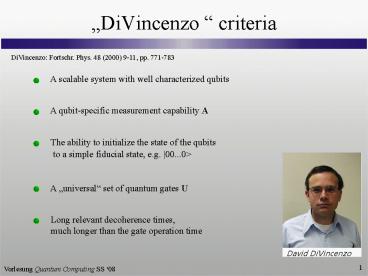DiVincenzo criteria - PowerPoint PPT Presentation
1 / 29
Title:
DiVincenzo criteria
Description:
coulomb repulsion couples motional degrees of freedom ... coulomb potential. positions at rest. 1 mode. 2 modes. A. Steane: quant-ph/9608011 ... – PowerPoint PPT presentation
Number of Views:66
Avg rating:3.0/5.0
Title: DiVincenzo criteria
1
DiVincenzo criteria
DiVincenzo Fortschr. Phys. 48 (2000) 9-11, pp.
771-783
A scalable system with well characterized qubits
A qubit-specific measurement capability A
The ability to initialize the state of the
qubits to a simple fiducial state, e.g.
00...0gt
A universal set of quantum gates U
Long relevant decoherence times, much longer
than the gate operation time
2
Quantum Computing with Ions in Traps
How to trap ions
State preparation
Qubit operations
CNOT
Deutsch Jozsa Algorithm
advantages/drawbacks
3
Paul Trap
Nobel Prize 1989
quadrupole field ? x and y motions not coupled!
centre is field free
Chemnitz University
4
Linear Trap
M. Sasura and V. Buzek quant-ph/0112041
z0
U1
U2
Uac(t) Ur V0 cos WTt
effective potential
feff wx2 x2 wy2 y2 wz2 z2
(averaged over one rf cycle)
wx wy gtgt wz
5
Potential
6
Ions in a Linear Trap
typical operation parameters
wz
Nägerl et al Phys. Rev. A 61, 023405 (2000)
7
quantum computing with ions
calculation
read-out
time
U
?
?
?
?
H
H-1
?YAY?
time
the ions are prepared to be in their ground state
kBT ltlt hwz
8
Doppler cooling
when absorbing a photon, also the momentum is
transferred
E hw p hk
E 0 p 0
E hw p hk
absorption
k
the net momentum of the spontaneous emission is
zero
for ions moving toward the laser beam the
light appears blue shifted ? use a red detuned
laser
9
side band cooling
Doppler cooling gets down to kBT hG/2
internal electronic ground and excited state
g?,e?
trapped ions moving in harmonic potential states
n?, n 0,1,2
cooling g,n? ? e,n-1? e,n-1? ? g,n-1?
10
ions used as qubits
11
40Ca as qubit
Nägerl et al Phys. Rev. A 61, 023405 (2000)
42P3/2
854 nm
42P1/2
1?
32D5/2
866 nm
32D3/2
detection
397 nm
quadrupole transition
729 nm
0?
42S1/2
quadrupole transition with relatively long
relaxation time for cooling 866 nm transition
has to be irradiated as well,
otherwise charge carriers will be trapped in
32D3/2 orbital fluorescence detection for
read-out
12
9Be as qubit
Monroe et al Phys. Rev. Lett. 75, 4011 (1995)
electron spin S 1/2, ms ?1/2 nuclear spin I
3/2, mI ?1/2, ?3/2 F I S, mF
sideband cooling
hyperfine levels have long relaxation times
13
quantum computing
quantum-bit (qubit) ?0? ? ? ?1? ? ?
calculation
read-out
time
U
?
?
?
H
H-1
?YAY?
time
14
qubit operations
how does the system evolve with time?
Splitting of S ½ in external magnetic field
B0 0.18 mT
15
qubit coupling
coulomb repulsion couples motional degrees of
freedom
N
N
Htrap S (wx2 xi2 wy2 yi2 wz2 zi2 )
SS
M
pi2
e2
2
4pe0 ri - rj
M2
i1
jgti
i1
A. Steane quant-ph/9608011
16
vibration modes as qubits (bus)
J.F. Poyatos et al., Fortschr. Phys. 48, 785
i1
i1
wi
A. Steane quant-ph/9608011
17
9Be the two qubit system
l 313 nm
s detection
1?
wz/2p 11.2 MHz
0?
F1, mF1?
22S1/2
1?
ws/2p 1.25 GHz
0?
F2, mF2?
F2, mF0?
0?
aux?
18
spin dynamics
g (My(t)Bz - Mz(t)By)
g My(t)Bz
Mxcos(wLt) Mysin(wLt)
g (Mz(t)Bx - Mx(t)Bz)
-g Mx(t)Bz
Mycos(wLt) - Mxsin(wLt)
g (Mx(t)By - My(t)Bx)
0
19
spin flipping in lab frame
http//www.wsi.tu-muenchen.de/E25/members/HansHueb
l/animations.htm
20
rotating frame
applied RF generates a circularly polarized RF
field, which is static in the rotating frame
21
spin flip in rotating frame
http//www.wsi.tu-muenchen.de/E25/members/HansHueb
l/animations.htm
22
qubit manipulation laser interaction
W mm B1/2h
frame of reference H0 hwsSz hwzaa
for w ws
Hman (Seij S-e-ij)
only spin state is changed
Lamb-Dicke parameter h 2pd0/l ltlt 1
23
qubit rotation
Qubit rotation on target qubit Up/2,ion
24
p/2- rotation matrix
Up/2,ion
Transformation matrix
25
CNOT operation
Monroe et al Phys. Rev. Lett. 75, 4714 (1995)
Uph transformation matrix
Uph
Transformation sequence
1
-1
0
0
1
1
0
1
1
0
0
-1
1
0
0
0
1
-1
0
0
1
0
0
1
1
0
0
-1
26
phase rotation
Phase rotation on control qubit Uph
Raman transition between 1 ? and auxiliary state
Full rotation by 2p
27
quantum computing
quantum-bit (qubit) ?0? ? ? ?1? ? ?
calculation
read-out
time
U
?
?
?
?
H
H-1
?YAY?
time
28
Be ions read-out spin state
0?
cool system to
s detection
1?
perform CNOT
0?
F1, mF1?
1?
read-out spin state via fluorescence
22S1/2
0?
F2, mF2?
29
Be ions read out vibrational state
read-out spin state
prepare same initial state and do CNOT
convert vibrational into spin state
1?
0?
F1, mF1?
1?
22S1/2
0?
F2, mF2?
read-out spin state via fluorescence































